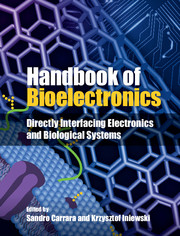Book contents
- Frontmatter
- Contents
- List of Contributors
- 1 What is bioelectronics?
- Part I Electronic components
- Part II Biosensors
- Part III Fuel cells
- Part IV Biomimetic systems
- Part V Bionics
- Part VI Brain interfaces
- Part VII Lab-on-a-chip
- Part VIII Future perspectives
- 40 Future perspectives in bioelectronics
- 41 Real-time activity energy expenditure estimation for embedded ambulatory systems using Sensium™ technologies
- 42 Electronic systems for health management
- 43 Linking the cyber and biological worlds: the Ensemble is the Function
- 44 Conclusion: Personal electronics and distributed theranostics
- Index
- References
40 - Future perspectives in bioelectronics
from Part VIII - Future perspectives
Published online by Cambridge University Press: 05 September 2015
- Frontmatter
- Contents
- List of Contributors
- 1 What is bioelectronics?
- Part I Electronic components
- Part II Biosensors
- Part III Fuel cells
- Part IV Biomimetic systems
- Part V Bionics
- Part VI Brain interfaces
- Part VII Lab-on-a-chip
- Part VIII Future perspectives
- 40 Future perspectives in bioelectronics
- 41 Real-time activity energy expenditure estimation for embedded ambulatory systems using Sensium™ technologies
- 42 Electronic systems for health management
- 43 Linking the cyber and biological worlds: the Ensemble is the Function
- 44 Conclusion: Personal electronics and distributed theranostics
- Index
- References
Summary
The future of bioelectronics has to follow from present electronics and present health needs. The present state of electronics is mainly based on personal computing (smartphones in our pockets, tablets and laptops in our handbags, navigators in our cars, etc.), while the new needs in health are based on personalization of treatments and therapies. This leads to the new concept of personal devices for health. Both the academic and the industrial world have already started targeting this new frontier, and the literature reflects that. New personal devices to be used directly by patients or on the patient’s body have been proposed recently: for example, sensors that provide artificial excitation to a portion of the patient’s body and acquire information about blood pulses [1], devices that integrate several sensors for measuring patient weight, temperature, blood pressure, and ECG waveforms [2], systems that also include personal storage devices [3], information management systems [4], and systems with a computer on board for receiving, storing, processing, and transmitting information [5].
It seems that the future will present us with wearable and/or implantable devices as commodities in medical technology. Good examples of that are several devices already present in the market, such as brain–machine interfaces [6], wearable monitors for vital signs [7] and/or physical activity [8], and personal glucometers, both hand-held [9] and implanted [10], which may now also be connected to an iPhone [11].
- Type
- Chapter
- Information
- Handbook of BioelectronicsDirectly Interfacing Electronics and Biological Systems, pp. 509 - 512Publisher: Cambridge University PressPrint publication year: 2015



